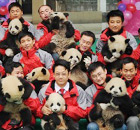Top News
Working across Guangxi-Vietnam border
By Rong Xiandong, Huo Yan and Li Qiufang in Nanning (chinadaily.com.cn)
Updated: 2010-02-04 16:08
 |
Large Medium Small |
At the peak season, thousands of people gather to cross the Dongxing border in the morning, according to border management officials.
Dongxing, the only Chinese city with both land and sea borders with ASEAN, has a total area of 540.7 square kilometers and a population of 110,000. Mong Cai, a key Vietnamese city open to the outside world with preferential government policies, has a total area of about 520 square kilometers and a population of about 100,000.
Dongxing joins Mong Cai through a bridge of over 100 meters long on the Beilun River.
Among the cross-border working population, the majority are local Dongxing people. One of the locals, Huang Sisheng, 20 years old, helps his elder sister run a shop selling daily necessities in Mong Cai. His sister has been running the shop for more than 10 years.
Some local people in Dongxing stop their businesses in Mong Cai because it's less profitable compared with several years ago as more people start businesses in the Vietnamese city, according to Huang.
But many business people from outside Dongxing are upbeat about the business potential in the cross-border region. "The business environment will greatly improve with Vietnam formally entering the China-ASEAN free trade area (FTA) in 2015 as now we still cannot enjoy the zero-tariff policy here," Luo said.
Many people like Luo buy goods including garment, shoes and toys from south China's Guangzhou city, central China's Zhuzhou city and east China's Hangzhou's city and sell them in Mong Cai.
The China-ASEAN FTA, expected to be the third-largest free trade zone in the world in terms of total trade volume, was inaugurated on the first day of 2010.
After the launch of the China-ASEAN FTA, more than 90 percent of goods will enjoy the zero-tariff policy crossing the border between China and six old ASEAN member countries including Indonesia, Malaysia, Thailand, Singapore, the Philippines and Brunei. Vietnam, together with three other new ASEAN members, will implement the same policy from 2015.
There are also many people who go to the other side of the border every day to work for companies, according to Long Xiangdong, a Dongxing border management official.
Li Wenfan, 56, a Vietnamese carpenter, works for a furniture factory in Dongxing. He goes to work at about 8:30 every morning and goes back to his home in Mong Cai at about 6 pm.
He gets paid in Chinese currency Renminbi. More and more people choose to use RMB in daily life and business transactions as the currency is on its way to appreciation with China’s economy roaring ahead, according to local people in Dongxing and Mong Cai.
Li speaks fluent Cantonese and has no difficulty talking to people in Dongxing, which used to be a part of Guangdong province in history, as many people speak Cantonese in the Chinese city.
While many Dongxing business people sell Chinese products including home appliances in Mong Cai, a lot of Vietnamese sell their products like rosewood furniture, perfume and seafood in Dongxing.
Bai Shixing, a 24-year-old Vietnamese woman, sells Vietnamese sea food in Dongxing. She comes to Dongxing as soon as the border gate opens in the morning and goes back home to Mong Cai after she sells out her products.
She said she can understand some standard Chinese or Putonghua and local dialects of Dongxing and can even speak a little bit of the Chinese languages. "Many Vietnamese products are well welcomed in Dongxing and there are a lot of business opportunities here in China," she said.







